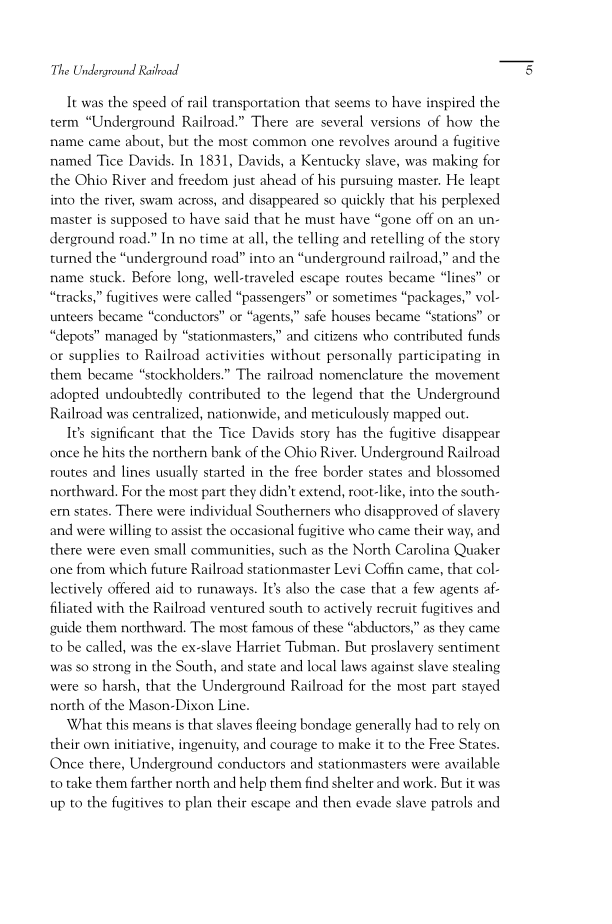The Underground Railroad 5 It was the speed of rail transportation that seems to have inspired the term “Underground Railroad.” There are several versions of how the name came about, but the most common one revolves around a fugitive named Tice Davids. In 1831, Davids, a Kentucky slave, was making for the Ohio River and freedom just ahead of his pursuing master. He leapt into the river, swam across, and disappeared so quickly that his perplexed master is supposed to have said that he must have “gone off on an un- derground road.” In no time at all, the telling and retelling of the story turned the “underground road” into an “underground railroad,” and the name stuck. Before long, well-traveled escape routes became “lines” or “tracks,” fugitives were called “passengers” or sometimes “packages,” vol- unteers became “conductors” or “agents,” safe houses became “stations” or “depots” managed by “stationmasters,” and citizens who contributed funds or supplies to Railroad activities without personally participating in them became “stockholders.” The railroad nomenclature the movement adopted undoubtedly contributed to the legend that the Underground Railroad was centralized, nationwide, and meticulously mapped out. It’s signifi cant that the Tice Davids story has the fugitive disappear once he hits the northern bank of the Ohio River. Underground Railroad routes and lines usually started in the free border states and blossomed northward. For the most part they didn’t extend, root-like, into the south- ern states. There were individual Southerners who disapproved of slavery and were willing to assist the occasional fugitive who came their way, and there were even small communities, such as the North Carolina Quaker one from which future Railroad stationmaster Levi Coffi n came, that col- lectively offered aid to runaways. It’s also the case that a few agents af- fi liated with the Railroad ventured south to actively recruit fugitives and guide them northward. The most famous of these “abductors,” as they came to be called, was the ex-slave Harriet Tubman. But proslavery sentiment was so strong in the South, and state and local laws against slave stealing were so harsh, that the Underground Railroad for the most part stayed north of the Mason-Dixon Line. What this means is that slaves fl eeing bondage generally had to rely on their own initiative, ingenuity, and courage to make it to the Free States. Once there, Underground conductors and stationmasters were available to take them farther north and help them fi nd shelter and work. But it was up to the fugitives to plan their escape and then evade slave patrols and
Document Details My Account Print multiple pages
Print
You have printed 0 times in the last 24 hours.
Your print count will reset on at .
You may print 0 more time(s) before then.
You may print a maximum of 0 pages at a time.

















































































































































































































































